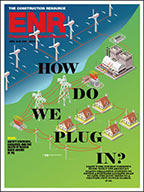...on a “twisted” jacket structure that has three legs angled around a central pile. Only one design, by a London-based consortium of Gifford, BMT Group Ltd. and Freyssinet, incorporates a concrete gravity base.
Mass production of the bases at a coastal facility could cut 30% off costs, says Gordon Jackson, a director at engineer Arup Group, London.
In January, the firm teamed with contractors Hochtief A.G., Essen, Germany, and the U.K.’s Costain Group, Maidenhead, to establish a production facility. “We think there is the capacity and capability to produce 200 foundations a year,” says Jackson.
Arup has identified 20 possible U.K. sites. The challenge is to do enough work to attract enough orders to justify investing in a production plant, says Jackson. It’s a “chicken-and-egg” situation, he says.
Hochtief dispelled any such uncertainties when it decided to invest in an installation vessel for the next generation of wind farms. The firm set up Beluga Shipping GmbH with a Bremen, Germany-based shipping company to design and procure a $200-million vessel. The self-propelled jack-up is being designed specifically to transport and install foundations and turbines.
The vessel will have a 1,500-tonne-capacity crane able to handle structures up to 120 m tall in 50 m of water, says Carsten Heymann, the joint venture’s managing director. Hochtief will decide this fall whether to order a second vessel.
The offshore-wind-power sector is preoccupied with cheaper production in deeper waters. But project engineers still have to deal with a fundamental design deficiency in monopiles that is troubling current developments.
The problem centers on the grouted annulus, or ring, between each monopile and the transition piece that slides over it to support the turbine and tower. Until recently, the shear connection formed by the grout transferred all the load to the seabed. But last year, increasing numbers of grout failures were reported. Immediate problems were averted because internal steel brackets included solely for installation work prevented towers from slipping excessively.
Making future monopiles slightly conical is the favored long-term solution, but builders of projects in production have had to improvise.
Among them is a Norwegian joint venture of Statoil A.S., Stavanger, and Statkraft A/S., Oslo. Its $1.6-billion Sheringham Shoal field off north Norfolk includes 90 monopiles, ranging from 4.2 m to 5.2 m in diameter and ranging in length from 50 m to 55 m.
In case of grout failure, “we are installing spring bearings between the transition piece and the monopile,” says project director Rune R�nvik. Late in June, the Danish turnkey contractor M.T. H�jgaard A/S, Copenhagen, began driving monopiles fitted with the bearings to restrain their transition pieces.
R�nvik estimates the additional cost of installing the bearings at around $16 million, but with no delays to the critical path. “[The design] doesn’t solve all the problems around the grout,” he concedes. However, it will prevent excessive settlement, he adds. Crews are placing Sheringham’s piles this year. Installation and commissioning of the 88 turbines, each rated at 3.6 MW, is expected to be complete by the end of next year.
That project will be a substantial but still relatively small step toward cutting the U.K.’s carbon footprint. “We need something like 40% of electricity to come from renewables,” says Benj Sykes, a CT offshore wind specialist. He adds, “Something like 60% of renewable electricity will come from offshore wind.”







